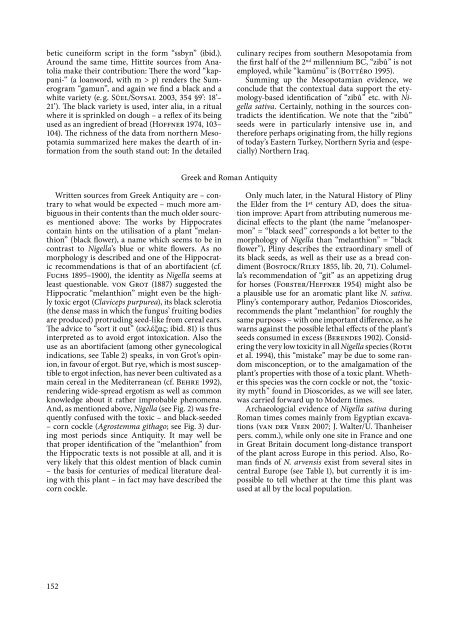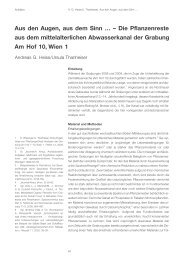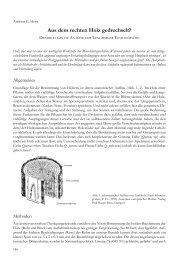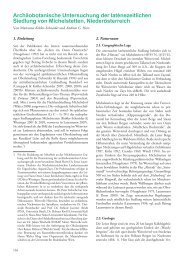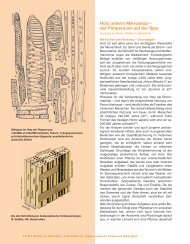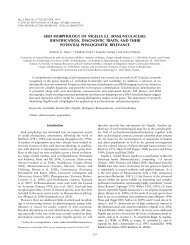View - erbsenzaehler.at
View - erbsenzaehler.at
View - erbsenzaehler.at
Create successful ePaper yourself
Turn your PDF publications into a flip-book with our unique Google optimized e-Paper software.
etic cuneiform script in the form “ssbyn” (ibid.).<br />
Around the same time, Hittite sources from An<strong>at</strong>olia<br />
make their contribution: There the word “kappani-“<br />
(a loanword, with m > p) renders the Sumerogram<br />
“gamun”, and again we find a black and a<br />
white variety (e. g. Süel/Soysal 2003, 354 §9’: 18’–<br />
21’). The black variety is used, inter alia, in a ritual<br />
where it is sprinkled on dough – a reflex of its being<br />
used as an ingredient of bread (Hoffner 1974, 103–<br />
104). The richness of the d<strong>at</strong>a from northern Mesopotamia<br />
summarized here makes the dearth of inform<strong>at</strong>ion<br />
from the south stand out: In the detailed<br />
culinary recipes from southern Mesopotamia from<br />
the first half of the 2 nd millennium BC, “zibû” is not<br />
employed, while “kamūnu” is (Bottéro 1995).<br />
Summing up the Mesopotamian evidence, we<br />
conclude th<strong>at</strong> the contextual d<strong>at</strong>a support the etymology-based<br />
identific<strong>at</strong>ion of “zibû” etc. with Nigella<br />
s<strong>at</strong>iva. Certainly, nothing in the sources contradicts<br />
the identific<strong>at</strong>ion. We note th<strong>at</strong> the “zibû”<br />
seeds were in particularly intensive use in, and<br />
therefore perhaps origin<strong>at</strong>ing from, the hilly regions<br />
of today’s Eastern Turkey, Northern Syria and (especially)<br />
Northern Iraq.<br />
Greek and Roman Antiquity<br />
Written sources from Greek Antiquity are – contrary<br />
to wh<strong>at</strong> would be expected – much more ambiguous<br />
in their contents than the much older sources<br />
mentioned above: The works by Hippocr<strong>at</strong>es<br />
contain hints on the utilis<strong>at</strong>ion of a plant “melanthion”<br />
(black flower), a name which seems to be in<br />
contrast to Nigella’s blue or white flowers. As no<br />
morphology is described and one of the Hippocr<strong>at</strong>ic<br />
recommend<strong>at</strong>ions is th<strong>at</strong> of an abortifacient (cf.<br />
Fuchs 1895–1900), the identity as Nigella seems <strong>at</strong><br />
least questionable. von Grot (1887) suggested the<br />
Hippocr<strong>at</strong>ic “melanthion” might even be the highly<br />
toxic ergot (Claviceps purpurea), its black sclerotia<br />
(the dense mass in which the fungus’ fruiting bodies<br />
are produced) protruding seed-like from cereal ears.<br />
The advice to “sort it out” (εκλέξας; ibid. 81) is thus<br />
interpreted as to avoid ergot intoxic<strong>at</strong>ion. Also the<br />
use as an abortifacient (among other gynecological<br />
indic<strong>at</strong>ions, see Table 2) speaks, in von Grot’s opinion,<br />
in favour of ergot. But rye, which is most susceptible<br />
to ergot infection, has never been cultiv<strong>at</strong>ed as a<br />
main cereal in the Mediterranean (cf. Behre 1992),<br />
rendering wide-spread ergotism as well as common<br />
knowledge about it r<strong>at</strong>her improbable phenomena.<br />
And, as mentioned above, Nigella (see Fig. 2) was frequently<br />
confused with the toxic – and black-seeded<br />
– corn cockle (Agrostemma githago; see Fig. 3) during<br />
most periods since Antiquity. It may well be<br />
th<strong>at</strong> proper identific<strong>at</strong>ion of the “melanthion” from<br />
the Hippocr<strong>at</strong>ic texts is not possible <strong>at</strong> all, and it is<br />
very likely th<strong>at</strong> this oldest mention of black cumin<br />
– the basis for centuries of medical liter<strong>at</strong>ure dealing<br />
with this plant – in fact may have described the<br />
corn cockle.<br />
Only much l<strong>at</strong>er, in the N<strong>at</strong>ural History of Pliny<br />
the Elder from the 1st century AD, does the situ<strong>at</strong>ion<br />
improve: Apart from <strong>at</strong>tributing numerous medicinal<br />
effects to the plant (the name “melanospermon”<br />
= “black seed” corresponds a lot better to the<br />
morphology of Nigella than “melanthion” = “black<br />
flower”), Pliny describes the extraordinary smell of<br />
its black seeds, as well as their use as a bread condiment<br />
(Bostock/Riley 1855, lib. 20, 71). Columella’s<br />
recommend<strong>at</strong>ion of “git” as an appetizing drug<br />
for horses (Forster/Heffner 1954) might also be<br />
a plausible use for an arom<strong>at</strong>ic plant like N. s<strong>at</strong>iva.<br />
Pliny’s contemporary author, Pedanios Dioscorides,<br />
recommends the plant “melanthion” for roughly the<br />
same purposes – with one important difference, as he<br />
warns against the possible lethal effects of the plant’s<br />
seeds consumed in excess (Berendes 1902). Considering<br />
the very low toxicity in all Nigella species (Roth<br />
et al. 1994), this “mistake” may be due to some random<br />
misconception, or to the amalgam<strong>at</strong>ion of the<br />
plant’s properties with those of a toxic plant. Whether<br />
this species was the corn cockle or not, the “toxicity<br />
myth” found in Dioscorides, as we will see l<strong>at</strong>er,<br />
was carried forward up to Modern times.<br />
Archaeologcial evidence of Nigella s<strong>at</strong>iva during<br />
Roman times comes mainly from Egyptian excav<strong>at</strong>ions<br />
(van der Veen 2007; J. Walter/U. Thanheiser<br />
pers. comm.), while only one site in France and one<br />
in Gre<strong>at</strong> Britain document long-distance transport<br />
of the plant across Europe in this period. Also, Roman<br />
finds of N. arvensis exist from several sites in<br />
central Europe (see Table 1), but currently it is impossible<br />
to tell whether <strong>at</strong> the time this plant was<br />
used <strong>at</strong> all by the local popul<strong>at</strong>ion.<br />
152


